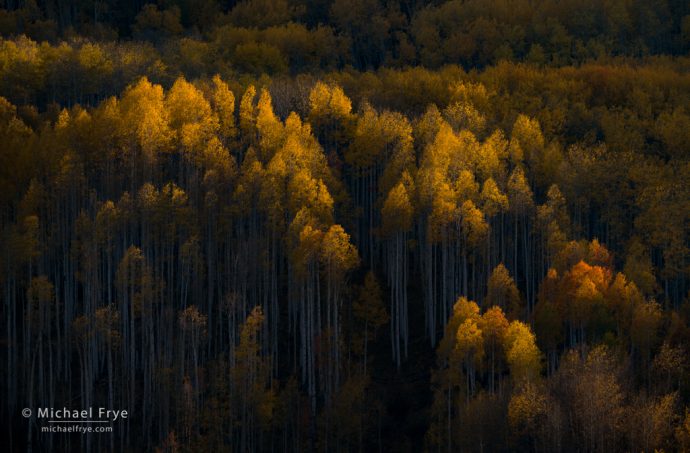
First light on aspens, Colorado. I waited for the sun to come up over a ridge and rake across this hillside, thinking that the first light catching the tops of the trees might be interesting. This turned out to be one of my favorite images from the trip. 297mm, 1/45th sec. at f/11, ISO 100.
After photographing fall color in northern Utah, and then having our course deflected toward Dinosaur National Monument, Claudia and I did finally make our way to the aspen groves in Colorado.
As we were quickly discovering on this trip, the pandemic has made outdoor recreation especially popular this fall, so well-known spots were busier than usual, and campsites hard to come by.
But there are lots of aspens in Colorado. Millions of them. If you’re in Colorado at elevations between 8,000 and 10,000 feet, there are bound to be aspens nearby. We didn’t have a particular timetable, so we looked at maps, picked out some likely spots, and just went.
We found lots of aspens, and few people. It was fun to just pick a road on the map and end up driving through miles of beautiful aspen groves. The hard part was there were too many choices; should we stop here, or try going up around the bend?
Colorado is known for its scenes of aspens and mountains, but those big-landscape views usually need some clouds or mist to lend them drama, and we didn’t run into much weather during this trip. We saw a few clouds here and there, and occasionally encountered a little smoke haze from forest fires, but that was about it. So instead I concentrated on photographing more intimate views of just the aspens themselves.
I made plenty of images in soft light around dawn and dusk, as that’s one of my favorite kinds of light for colorful subjects like autumn trees. But I also looked for moments when sunlight would filter into a grove early or late in the day, creating contrast, drama, and mood.
One of the advantages of photographing in sunny weather is that the light is predictable. If a grove of aspens catches interesting light in the evening one day, you can count on seeing that same light the next day. Even in new locations it’s easy to predict the angle and timing of early- and late-day sunlight.
I almost always looked for situations where a grove would be backlit. Sometimes I’ll find a scene where sidelight or frontlight will work, but backlight shining through translucent aspen leaves is pretty special.
Here’s a selection of some of my favorite sunlit aspen scenes from Colorado this fall. Sometimes I just happened to notice interesting light hitting a grove or hillside; other times I went to a spot specifically because I knew it would catch some early- or late-day light.
And I made lots and lots of aspen images during our trip, so I’m sure I’ll post more soon.
— Michael Frye
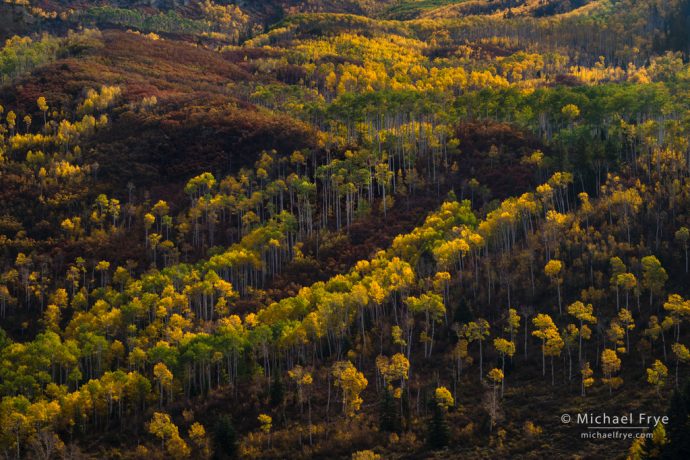
Autumn hillside with aspens and oaks, Colorado. I photographed this hillside the previous evening in soft light, and decided to come back the next morning when sun got high enough to backlight the scene. 98mm, 1/20th sec. at f/11, ISO 100.
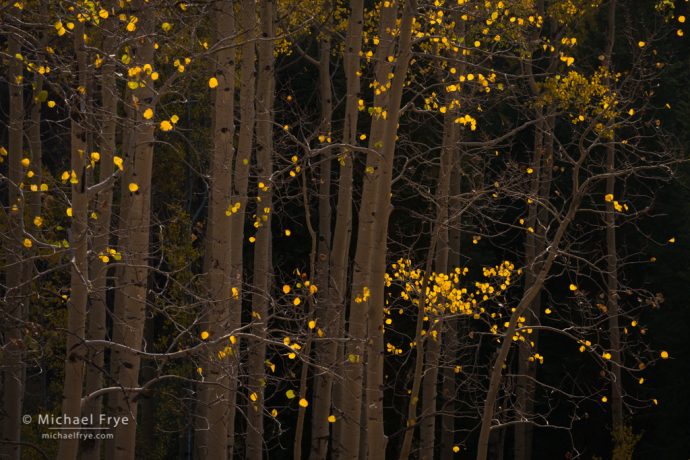
Forest glow, Colorado. An interesting side-canyon full of aspens caught our attention. I found a rough trail up the canyon, and then climbed up an open hillside where an old avalanche must have cleared out the forest, allowing me to step back and get some telephoto views of the surrounding trees. I found this little scene just as the sun came up over the ridge on the opposite side of the canyon, backlighting the leaves while the background was still in shade. 145mm, 1/15th sec. at f/16, ISO 100.
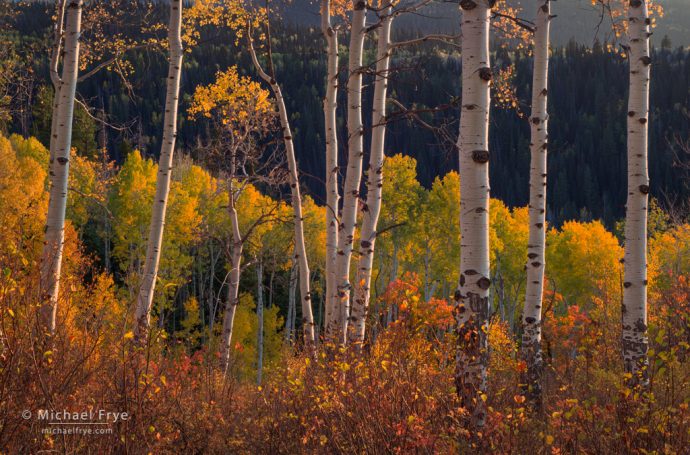
Oaks and aspens, last light, Colorado. Claudia and I hiked up to this hillside in the morning, but I could see that this west-facing grove would catch some late-afternoon light, so I came back that evening and found this view. 50mm, 1/8th sec. at f/16, ISO 100; focus-stacked.
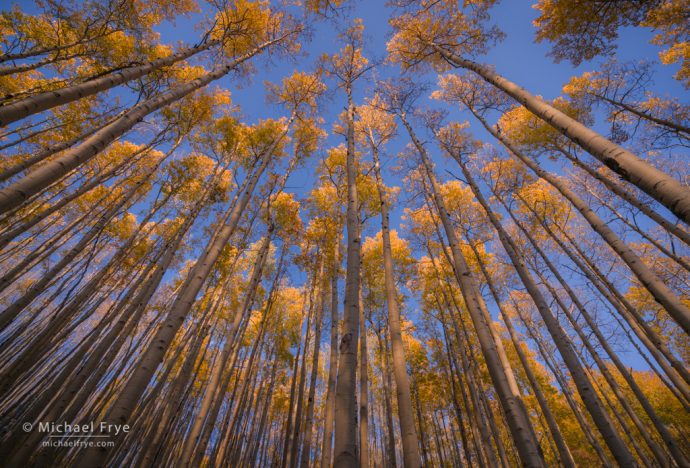
Aspen canopy, Colorado. We found a beautiful roadside grove, with a carpet of aspen leaves on the forest floor, and understory firs decorated with yellow leaves. I called it the Enchanted Forest. As we explored further, I saw some tall aspens catching the last light of the day, and found this symmetrical composition. This scene is actually frontlit; every other image here is backlit. 16mm, 1/125th sec. at f/11, ISO 200.
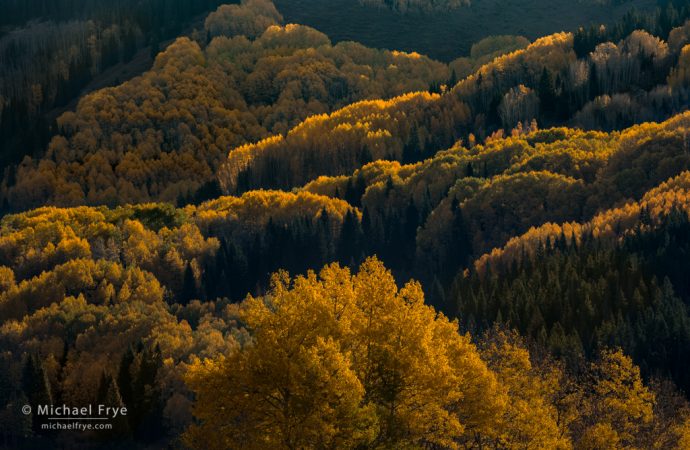
Aspen-covered hillsides, Colorado. After photographing inside some backlit aspen groves, I climbed back up to where we were parked and noticed the light catching the tops of the aspens across the valley. 154mm, 1/45th sec. at f/16, ISO 100.
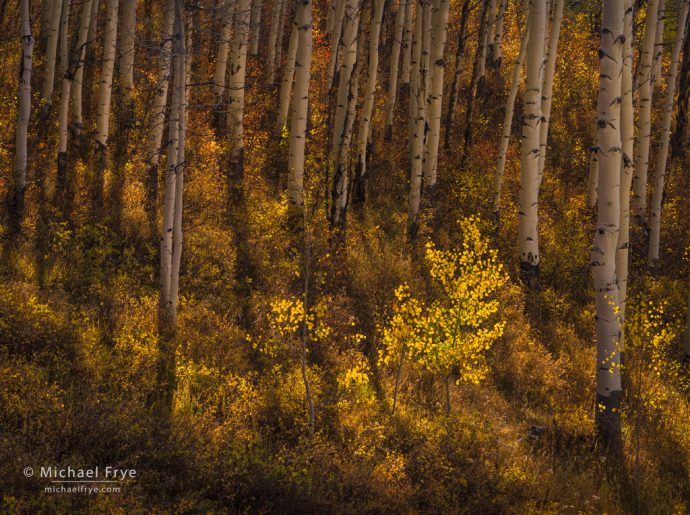
Aspen understory, Colorado. This is one of the scenes I photographed before capturing the previous image. 200mm, 1/45th sec. at f/16, ISO 100.
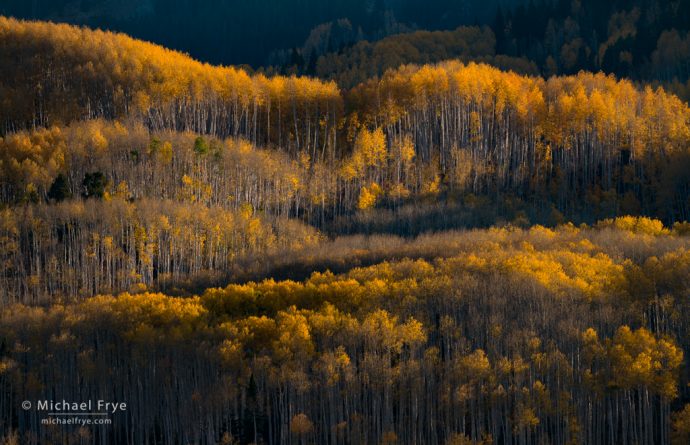
Morning light on aspens, Colorado. I made this image about two minutes after making the photograph at the top of this post, looking at a different part of the hillside. 253mm, 1/30th sec. at f/11, ISO 100.
Related Posts: On the Road; Land of Dinosaurs; Colorado Autumn
Michael Frye is a professional photographer specializing in landscapes and nature. He is the author or principal photographer of The Photographer’s Guide to Yosemite, Yosemite Meditations, Yosemite Meditations for Women, Yosemite Meditations for Adventurers, and Digital Landscape Photography: In the Footsteps of Ansel Adams and the Great Masters. He has also written three eBooks: Light & Land: Landscapes in the Digital Darkroom, Exposure for Outdoor Photography, and Landscapes in Lightroom: The Essential Step-by-Step Guide. Michael has written numerous magazine articles on the art and technique of photography, and his images have been published in over thirty countries around the world. Michael has lived either in or near Yosemite National Park since 1983, currently residing just outside the park in Mariposa, California.









The backlight and contrast on those images creates an almost Chiaroscuro-like effect. Thanks for sharing these Michael.
Thanks Peter – and you get points for knowing what “chiaroscuro” means. 🙂 Seriously though, some of the most consistently interesting and effective lighting conditions involve placing a light object against a dark background – if you can get a clean juxtaposition of light against dark, not a random splotchy mishmash.
I love your “macro” fall foliage photography. It is so hard, at least for me, to get good images of the “large picture”, i.e., the whole hillside, valley, etc. During fall color trips for me, I tend to dwell on smaller sections of color and less on the “big picture”. I did get some good ones in Oak Creek Canyon above Sedona Fri/Sat. It should be peaking in another week. You have time to get there Michael! 🙂
I think it’s difficult to make really good “large picture” photographs of any subject without interesting clouds, or a clearing storm, or some kind of weather. Of course there’s more to it than that – composition is huge. But weather is often essential. So when the weather isn’t going to add something to the sky, I usually leave the sky out, or minimize it, and focus on a smaller section of the landscape. And it’s easy (or easier at least) to find interesting compositions of those smaller scenes when you have a great subject, like fall color.